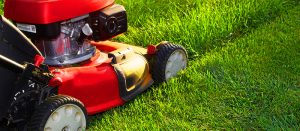Spring is a busy time of year for gardeners. It’s the time to help your plants bounce back after winter and to make sure they’re ready to face the upcoming summer. Your lawn is no different.
When the sun starts to peek through the clouds and the ground starts to warm up, your lawn will begin to wake up too. Post-winter and pre-summer lawn care are important for the health and longevity of your turf. Along with fertilising, watering, and dethatching, spring mowing routines are critical for a lush green lawn.
To ensure you’re giving your lawn the best trimming treatment, we’ve found the five best mowing tips for spring.
Check the condition of your lawn mower
After sitting in the shed all winter, your mower is about to get a whole lot of use. You want it to be up to the task. Check that the screws are tight, fill it with fuel, empty the catcher bag if you use one, and check that the blades are sharp. If you’ve got a petrol-powered mower check the oil level, the spark plugs, the carburetor and the tank. Get the whole mower serviced if it hasn’t had a check-over by a professional in a while.
Don’t start too early
Give your lawn a chance to fully sprout before you start at it with the mower. Once the ground starts to warm up and the grass starts to germinate, it’ll need about a fortnight for the sprouts to properly mature.
Mowing too early risks compacting the grass or killing off fragile fresh lawn. The grass needs to have matured enough to handle being cut before you actually take to it with your power tools.
Some people wait two weeks after germination, while other rules of thumb use spring flowers to measure when the lawn is ready for mowing. Old gardening wisdom suggests that the first spring mowing should be done when the tulips or daffodils have lost their petals.
Frequent, short trimming is better than infrequent, large cuts
In mid-spring, when your lawn is back in business and merrily growing in the warmer days, it’s best to maintain a frequent mowing schedule so as to not let the lawn get too long.
For healthiest turf, blades of grass shouldn’t be cut more than a third of their length. Therefore, depending on the grass, you don’t want to let it get too long as you’ll be cutting off more than a third to get the grass back to the desired height. Cutting off more than a third puts unnecessary strain on the lawn.
You want your lawn to improve from the mowing, not struggle to survive afterward!
Trim to the optimum height for the grass type
Some grass varieties are made to be kept longer than others. Maintaining your lawn at a length appropriate for the grass variety will help to keep it lush and healthy.
Cool season varieties such as fescues, Kentucky bluegrass, and annual and perennial ryegrasses should be mowed to a taller height. They should be kept at least 5cm tall – somewhere between 5 and 10cm is the perfect height. Tall fescues can be kept even longer.
Warm season grasses like zoysia, couch, buffalo, kikuyu like to be kept shorter. Aim for between 2 and 4 centimetres in length.
Bent grass is one of the shortest varieties – its ideal mowing height is anywhere from 2 centimetres down to a bowling-green level of cropped at just a quarter of a centimetre.
Don’t use a catcher
In spring, your lawn needs all the nutrients it can get. A prime source of those nutrients is lawn clippings themselves. Leaving lawn clippings on the turf in winter can cause problems by blocking sunlight to the grass and not decomposing, but in spring neither of those should be an issue. The clippings should break down and provide a lovely natural fertiliser to your turf.
As long as you’re maintaining that frequent mowing-only-one-third-of-the-blade-height schedule, get rid of the catcher bag and let that free fertiliser fall straight back to the ground!


